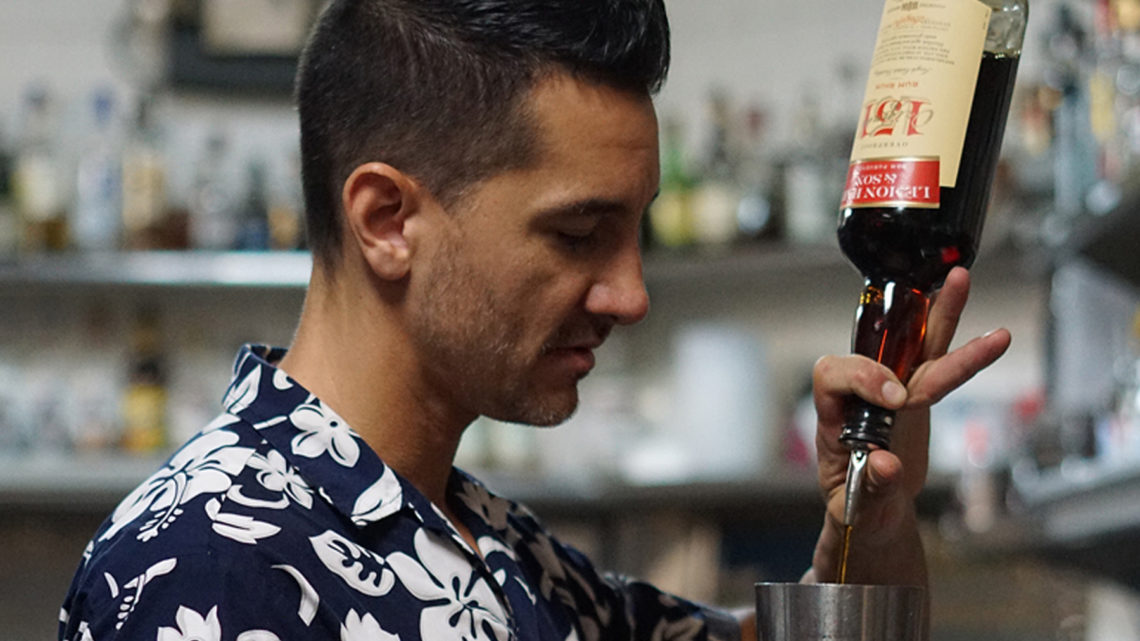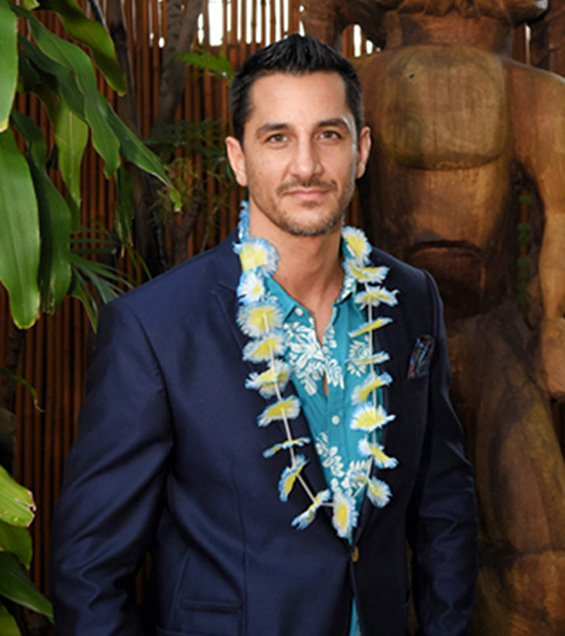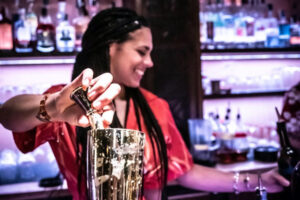Rum talks with MILES MAXIMILLIAN – Lemon Hart & Son Rum Global Brand Ambassador

1. Who is Miles Maximillian Vrahimis?
Miles Maximillian Vrahimis is the Global Brand Ambassador for Lemon Hart & Son Rum and former Mai-Kai head mixologist. Having worked in the hospitality industry since 2004, Miles started exploring the world of rum back in 2010 when he was working for Rémy Cointreau in Miami Beach. He began collecting vintage spirits in 2012 and has been obsessively researching, reviewing, and creating cocktails for the last 12 years.
2. What does the rum mean for you? What made you fall in love with rum and when did it happen?
I was a late-comer to the world of rum. Back in 2010, hardly anyone was sipping rum, however, having worked for Rémy Cointreau, I was exposed to rum, yet I was more into Champagne and Cognac at the time. Rum was last to the table, but hit me the hardest. I remember when I started collecting old bottles back in 2012 – I purchased a 1990s Coruba Dark in a dusty old liquor store for $12, on the recommendation of a friend of mine, Benny Wollowitz, that sparked a crazy obsession ever since. To me, rum represents limitless possibilities – a trapdoor to another place whose geography and time is uncertain. I remember the first time I tasted a 1950s Lemon Hart 15-Year Jamaica – you remember that taste and it stays with you; you are forever chasing that rum taste again. You may find it, you may not, but that’s what we always end up chasing.
3. Three essential characteristics that define the rum according to your perspective.
Firstly, since rum is produced from sugarcane (as opposed to grain, agave, or grapes etc.) the product has to display some characteristics of sugarcane. To me, that is the most important thing. There are several rums that taste like whisky and they appeal to whisky drinkers, but they are not really leading the class description of rum. Secondly, I would say smoothness, complexity, and body. You have to take your time with a rum. A good rum should be stimulating, exciting, and vibrant. Thirdly, loyalty to tradition and heritage of the category. Too many brands out there have become so cute that they’ve drifted away from the tradition of rum, instead trying to be a vodka or whisky in order to get sales.
4. What is the most important contribution you have made in the rum industry?
Helping spread the message and importance of rum where ever I go. If I go to a dinner party, function, or just to a friend’s house, I’ll always bring a bottle of rum as a way to introduce someone to the category. In fact, I’ve even brought my doctor a bottle of rum before. Lemon Hart & Son, 100% pure Demerara rum from Guyana, has a very unique taste characterized by a full-flavor with distinctive “brown” notes – toffee, leather, steeped tea, molasses, dried fruit, and heavy barrel notes.
5. Benefits that the rum industry has given you.
Industry access, exposure to trade journals, periodicals and newsletters, as well as the ability to meet a great deal of master blenders, writers, other brand ambassadors and experts in the field. The rum community is very small so it is important for everyone to stick together. I am not part of the so-called ‘rum family’ as it were, since I prefer to work behind the scenes.
6. What’s another thing you are passionate about, in addition to rum? Why?
Photography, mixology, and graphic design. All of these skills have allowed me to continue passionately working within the rum industry since many of these skills come into play more often than not. For example, I am able to create a cocktail, shoot a cocktail, create promotional material to advertise the cocktail, and then finally serve the cocktail to the customer. Being vertically integrated has proven to be an absolute blessing.
7. What is your favorite place for drinking rum?
At home in the kitchen with a notepad and pen taking detailed notes well into the early hours. It may sound mundane, but by sampling and comparing on a daily basis, you develop a greater appreciation for rum. A rum can’t be everything to everyone – that’s the reality. For me, the learning comes first. Then the drinking. Then the whole social aspect of it all. All three are difficult to separate. Rum doesn’t ask you to put it in a box
8. Favorite drink + Recipe
“Black Bird”
1 ½ oz Lemon Hart Blackpool Spiced Rum
¾ oz Campari
1 ½ oz Pineapple Juice
½ oz Lime Juice
½ oz Simple Syrup
Method: Combine all ingredients into a shaker with 1 cup of crushed ice. Hand shake and strain into an old-fashioned glass with a single large ice cube. Garnish with a pineapple wedge adorned with a cherry and pineapple leaves to look like a jungle bird.
Tasting Notes: The aged Demerara and amaro gives this drink a decidedly spiceforward backbone, but each of their nuances shine: the American oak that holds aging bourbon gives Blackpool Spiced Rum accentuated vanilla and coconut notes, along with the high-impact spice blend of cinnamon, nutmeg, clove, and black pepper, bringing richness and body, while the bitter and tart elements of the amaro results in a balanced, complex, and meticulously “umami” beverage.
9. Why is it important to educate the rum consumer?
Rum is one of the most diverse spirits in the world, yet there are still quite a few misconceptions, most notably about color, age, and added sugar. Most categories other than rum (vodka, gin, tequila, whisky etc.) are closely regulated so their methods are more defined and not open to experimentation. Bourbon especially with mash bills, new charred oak (which is mandatory), and even distillation strength and barrel strength, which means they all taste quite similar. Cognac much the same. In contrast, rum is not closely regulated, perhaps because distilleries are so remote and in third world jurisdictions where controls are limited; Spanish-style rums are especially not subject to restricted methods of distilling, maturing, and blending. The only commonality is that they are all made from sugar cane.
Some of the best rums are aged between 2 and 7 years because of the rapid maturation due to the heat. It is hard to get that through to people who have been drinking whiskey all their lives, who have been trained to think that age is quality – that 18 years in whiskey means quality, but in rum ‘18’ does not mean quality. It’s all in the mind. Look at tequila: it is much easier to convince people that a 2 or 3-year tequila is the best thing they could buy. Añejo tequila is 2-3 years old and a reposado is 18 months. In terms of whisky, that is really young, but that’s what that category is. Rough guidelines are necessary for rum, but not so rigid (like the whole push for a “true rum” position) that they stymie innovation and creativity to keep the category interesting.
The key is for local regions or islands to maintain geographic character. It is difficult to get compromise/agreement on regulations. That said, good rum awareness helps consumers understand their options and ultimately allows them to become active participants in the buying process. At the end of the day, good consumer education, transparency, and honesty, only helps reinforce a brand’s value. Confusion causes hesitation, and hesitation can easily turn into no purchase at all.
10. Any tips to train the palate and taste a good premium rum?
First, find some good glass – something like a stemmed Cognac Hennessy or Glencairn Copita. Take in the aroma first. Then start with small sips and take notes. Sometimes you may need to “burn” your palate, so be prepared to take slow sips. What do you notice on the tip of your tongue? The first taste is very important. Move the rum around your cheeks. Does the taste change? Compare and contrast in order to really notice the differences. The longer you keep the rum in your mouth, the more it will help to reveal enough flavors of the rum. Taste as much as you possibly can. I always take notes when I sample rum. I rate out of five, according to Aroma, Taste (including body and finish), and Mixability (using one of three Litmus tests). Not all rums are crafted for mixing, however, I still test them to see how they hold up. One trick I’d recommend after sipping it to leave the empty glass sitting for a few hours; even though empty, it contains the dry extract and all the substances of the rum that do not volatilize. If you then sniff the glass, you’ll get a pungent concentrate of the structure around which the aromatic profile of the rum has developed. My palate today is ten times better than it was even three years ago.
11. How can the rum contribute to improving the crisis in some countries?
I think as rum continues to expand and evolve and become more socially relevant, more developing countries are going to be in a better position to move away from commodities (which fluctuate over time) and capitalize upon development of a strong export market, in addition to offering favorable tax incentives for inward investment. Also, the Geographical Indications Act of 2008 is very important because it allows certain countries the opportunity to not only promote and protect their rum in competitive overseas markets, but ultimately to protect their reputation and give consumers confidence in a rum’s authenticity and value for money. Having said that, however, there are some rum producers out there who tend to try to push their methods on to other producers by encouraging “true rum” regulations – most of which use classic whisky-making procedures using no additives. Ultimately compliance with international standards and best practices, particularly with regards to sustainability, is what will ensure success going forward.
12. Is the commitment to sustainable development the key of success for the permanence of the rum industry in the world? Why?
Absolutely. Craft rum is becoming a bigger part of the industry as distillers experiment with different ingredients and processes, however, at the same time, the biggest contributor to the industry’s carbon footprint is the distillation process itself. To help offset the impact, the spirits industry has adopted several best practices for sustainability which a lot of companies are embracing. In truth, many consumers expect environmentally sound efforts be implemented in as many ways possible and have shown they are willing to support companies with strong environmentally sound business initiatives and a willingness to reject companies who don’t comply. Ultimately, you’ll be a more sustainable business in the long term by setting an industry-first example in responsibly managing the environment.
13. Who would like to meet in the rum industry? What would you say to him/her?
Luckily, having worked at the Mai-Kai, I’ve pretty much met most of the main rum and Tiki people. I’d love to meet Oswald Greenslade (creator of the Bahama Mama, Sukiyaki, Bikini Below the Knees, Splish Splash, and numerous other cocktails). I’d probably ask him what his “secret” was to have continually come up with so many award-winning, bankable cocktails that are still riffed to this very day. Others would probably include Luca Gargano, Simon Difford of Difford’s Guide, and Richard Paterson. One person who I had always wanted to meet was Stephen “The Professor” Remsberg, however, we connected a few years ago, and I’ve since visited him numerous times at his home in New Orleans and we’ve become very good friends over the years.
14. What are your next goals in the rum industry?
To continue learning and expanding my knowledge and understanding of rum, particularly from a chemical perspective, but also with an eye towards the category’s continued premiumization and evolution. Rum will always continue to be an economic fact of life for me.
15. Plans you have when you leave the rum industry.
No plans as of yet since there is still much to learn and perfect. Rum is constantly changing and evolving so the trick is to always stay relevant and on top of trends. My best guess is that I will always somehow be closely connected to rum, either as a collector, author, or proprietor.
16. Why is the role of the bartender important in the rum industry?
Traditionally, brands are built on-premise, which means that the role of the bartender, as your first point of contact for a new product, is critical. Yet one reason so many rum companies struggle with the on-premise channel is they fail to understand the distinctions that make on-premise unique from the off-premise world. Success on premise is a get-rich-slowly proposition. Add to this the many misconceptions about rum, and you can easily see how challenging this becomes. This is where a good bartender is crucial, not through being a good salesperson, but through creating awareness, value, and ultimately a good customer experience. A better-informed consumer is always going to have more of an emotional connection to a brand and increases loyalty over time. A good bartender will be skilled at creating these types of experiences, helping consumers solve problems, hopefully building word-of-mouth buzz in the local community at the same time.
17. What is your advice for new generations in the rum industry?
Test, test, test! And take detailed notes. Live, breathe, and sleep it. I always say, if it is not being measured, it is not being improved. It is necessary to continually be tasting and comparing to be considered an authority. In the latter sense, I am still waiting to “graduate”. I often get accused of being obsessed with rum – I’ve even been told I sometimes talk about it in my sleep. The way I see it, either be obsessed, or be average. Also, find a mentor. Stephen Remsberg was an early mentor to me and we still consult regularly on rum-related matters. I’ve spent hours picking his brains about hundreds of things. His knowledge of rum, rum history, and particularly, classic Don the Beachcomber cocktails, is unsurpassed. Another individual who has inspired me and helped me to develop my palate is Scott French (aka The Rum Trader), a South Carolina-based rum judge and fellow collector extraordinaire.
18. How can people learn more about you? Website? Social media page?
Our company website can be found at www.lemonhartrum.com in addition to a
personal blog I have at www.drunkentiki.com














